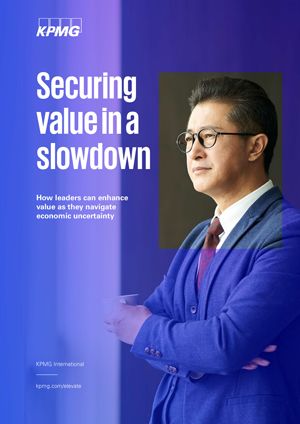The economic trends influencing decision-making today
KPMG International’s “Securing value in slowdown” report looks at trends influencing decision-making today and explores what actions CEOs are planning. But our series of crises are without precedent, therefore the consideration are more difficult and complex. As such, we explore how leaders can start to quantify and prioritize their various options as they navigate their companies through economic uncertainty.
Even before the current economic volatility, business leaders were grappling with a range of disruptive trends that were reshaping entire industries and sectors. The economic situation has only raised the stakes. Our recent look at the automotive industry is illustrative. Now, decisions become more critical as investment risks increase; and strategies need to account for more and more unforeseen implications.
Navigating the downturn
Business leaders are asking their advisors to predict what type of downturn they might be facing. Will it be a :
- V-shaped recovery — like the ‘COVID recession’ that lasted for just a few months in early 2020?
- U-shaped recovery — a deep and prolonged downturn, like the one that began with the financial crisis of 2008?
- W-shaped recovery — a recovery followed by another contraction?
- Or should business leaders anticipate a recession that doesn’t conform to established patterns?
The shape matters.
Companies planning for a severe or U-shaped recession would slash costs, horde cash, and hunker down. KPMG International’s Global CEO Outlook survey indicates that the majority of CEOs are planning to do just that: many say they plan to freeze hiring and reduce their workforce; more suggest they will increase prices in order to manage increasing supply chain costs.
Or perhaps the recession turns out to be mild and short, rewarding those companies that invest in growth strategies, capabilities, or innovation. Some CEOs are thinking more strategically about their technology and transformation investments and objectives in the face of economic uncertainty. But how can they be confident these investments will pay off?
M&A in times of a slowdown
Dealmaking was once almost exclusively about generating growth: quickly and inorganically. More recently, CEOs are shifting the reasons why they make deals.

Operational changes to counter the challenges of today

Seek opportunities and prepare for what may lie ahead

Digitally transform by acquiring critical capabilities
While there has been a general cooling in deal markets in 2022, there is good reason for optimism: annual deal volume in 2022 exceeded every year prior to 2021. With much deal activity focused on digitizing and transforming organizations, we expect to see this strong activity continue into the year. However, given the correlation between earnings expectations and dealmaking appetite, we have reason to be cautious as well.
CEOs expecting high earnings growth over the next three years were more likely to report a high appetite for dealmaking; those with low growth expectations reported low appetite for dealmaking.

Five key steps to confident decision-making
Ultimately, KPMG professionals believe there are five key steps to securing value in an economic downturn. In the full report (PDF 1.14 MB), we deep dive into each step and provide a case study to help further illustrate how value is created.
Start by assessing the externalities that might influence your decision-making. Then consider what is driving your business strategy.
Making it real
Agility through insight
A B2B maintain market leadership through a more effective R&D function and a better return on capital.
Attach a reliable and practical dollar amount to each opportunity, providing decision-makers with a real baseline against which to assess their options.
Making it real
Doubling EBITDA in 12 months
via mapping the right opportunities meant a family-owned mid-sized retailer was able to face rising inflation and increasing competition.
Find a good balance between short and long-term activities in order to help unlock in-year savings that can fund out-of-year transformation objectives.
Making it real
Unlocking US$150 million in value
first required a pricing and cost-to-serve assessment, powered by proprietary data and deep sector experience to identify value-creation opportunities.
Make sure you have the right skills, capabilities and talent to not only deliver your objectives, but also to sustain them.
Making it real
Quick wins to long-term value
by ensuring rapid cost reductions were mapped against the long term strategic objective to enable a long term transformation.
Be ready to rapidly course-correct when new trends or disruptions emerge — based on reliable data and a clear understanding of the business objectives.
Making it real
Continuous tracking enables quick pivot
to take advantage of opportunities as they emerged, giving them a level of agility that their competitors would struggle to duplicate.

Securing value in a slowdown
How leaders can enhance value as they navigate economic uncertainty
KPMG International’s report looks at trends influencing decision-making today and explores what actions CEOs are planning. But as cascading crises continue, business considerations are more challenging and complex. Explore how being data-led and value-focused has helped businesses navigate through economic uncertainty.
Download PDF (1.1 MB) ⤓
How can KPMG help you realize value?
KPMG's goal is to help you through your transformation or crisis so you can focus on delivering on your business objectives. Find out how KPMG firms use our global expertise, a multidisciplinary approach and wide-ranging experience to support your organization.
Connect with us
- Find office locations kpmg.findOfficeLocations
- kpmg.emailUs
- Social media @ KPMG kpmg.socialMedia




